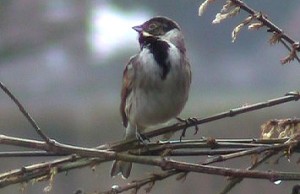 There is a certain amount of mystery surrounding the reed bunting and one reason is its name. “Reed” conjures up all sorts of wet areas such as marshy areas and areas of reeds, especially along the fringes of some lochs. The secret is the fact that at one time reed buntings were indeed only found in wet areas although they did feed on nearby farmland where their main food was seed. However, the situation changed as the efficiency of modern farming techniques meant less spilled grain. Then the tidying up of remaining areas took place and many, even very small marginal areas once ignored by the farmers, were drained and taken into cultivation. The reed buntings adapted by moving into much drier areas and now it can be found breeding in a wide range of “dry” places. One example is marram grass on sand dunes, hedgerows and even fields planted with oilseed rape. Why oilseed rape fields attract them is another mystery, still unexplained
There is a certain amount of mystery surrounding the reed bunting and one reason is its name. “Reed” conjures up all sorts of wet areas such as marshy areas and areas of reeds, especially along the fringes of some lochs. The secret is the fact that at one time reed buntings were indeed only found in wet areas although they did feed on nearby farmland where their main food was seed. However, the situation changed as the efficiency of modern farming techniques meant less spilled grain. Then the tidying up of remaining areas took place and many, even very small marginal areas once ignored by the farmers, were drained and taken into cultivation. The reed buntings adapted by moving into much drier areas and now it can be found breeding in a wide range of “dry” places. One example is marram grass on sand dunes, hedgerows and even fields planted with oilseed rape. Why oilseed rape fields attract them is another mystery, still unexplained
Another mystery is why reed buntings have, in the last few years, started coming more frequently into gardens to feeders. It seems incongruous that a bird associated with wet areas should suddenly start feeding in gardens and rubbing shoulders with greenfinches and siskins. This, however, goes back to the lack of grain in fields and this is why you can occasionally see reed buntings in gardens in the winter. Beware, however, as the male lacks the conspicuous colours of their summer plumage and can look more like female yellowhammers and easily overlooked. Yet another mystery is why some breeding reed buntings are resident all the year round whilst others migrate south such as to other parts of the British Isles and even to the Continent. I have had them in the garden during the winter, generally in poor weather, and the spring is the most likely time to see them. Then the males start to moult into their summer coat, as in the photograph, and are easy to identify from other birds.
In the summer I like to look for the breeding pairs and one such place I visit is the west end of Loch Flemington to the east of Inverness. There they nest in the wet areas right near the road, rather like their haunts would have been in the past. One year recently I found them feeding in the oilseed rape field on the opposite side of the road. The other place I look for them is on the way down the path to the hide at Loch Ruthven to the south of Inverness. There they breed in what would have been their old haunts in the wet areas fringing the loch. Just occasionally reed buntings will roost in small flocks and this is normally in such places as reed beds where they are relatively safe from predators.
Unfortunately, as with many other birds that relied on farmland for their food, the reed bunting has decreased in the last 30 year although the numbers in Scotland have been steady. This has been directly attributed to increases in land drainage and agricultural intensification. For the general decrease in the UK, the bird is now classed on the red list which includes the most threatened birds in the UK. There are many Scots names for the reed bunting and most of them derive from the black head and throat and others from the white neck ring. There are two Gaelic names with the commonest being Ceann-dubh-fraoich meaning “Blackhead of the heather”
